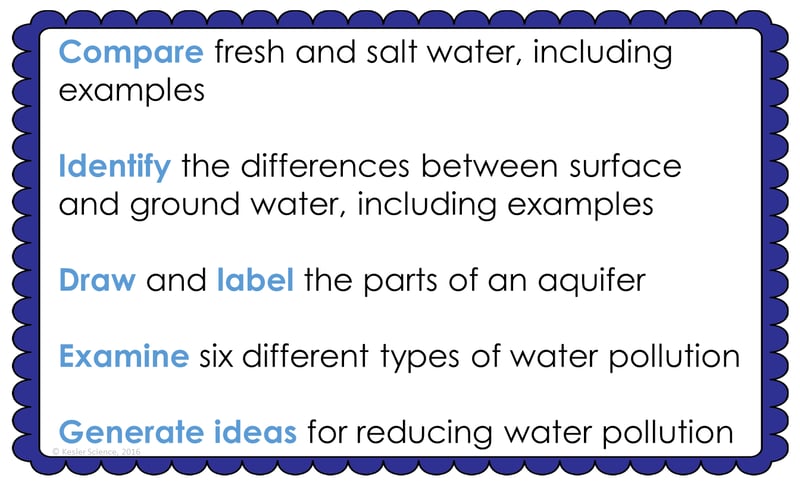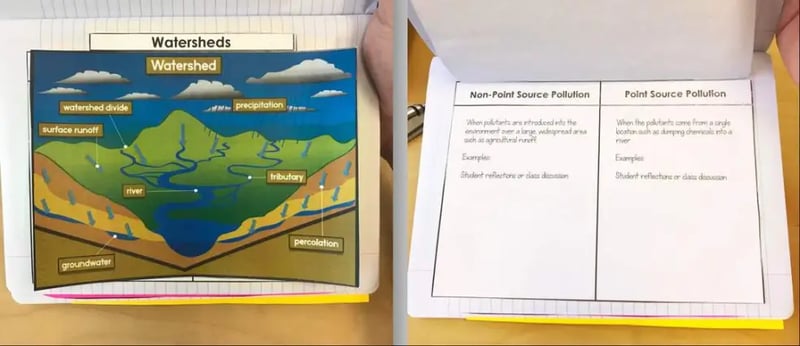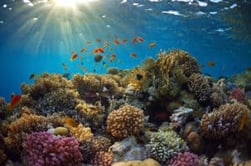Watersheds Lesson Plan - A Complete Science Unit Using the 5E Method of Instruction
By the end of this watersheds lesson plan, students will be able to compare fresh and salt water, identify the differences between surface and groundwater, draw and label the parts of an aquifer, examine six different types of water pollution, and generate ideas for reducing water pollution. Each of our lessons is designed using the 5E method of instruction to ensure maximum comprehension by the students. This well-thought out unit does the heavy lifting, giving teachers easy-to-implement, highly engaging lesson plans.
This blog will walk you through each of the steps and activities included in the Watersheds 5E lesson plan.
ENGAGEMENT
Objective Introduction
At the beginning of the lesson, the class will do a Think-Pair-Share to discuss the objective.
Class Activity
- Ask students to give a definition of surface water (water found on the Earth’s surface).
- Ask them to identify types of surface water (oceans, rivers, lakes, ponds).
- Tell them some surface water is locked up in icebergs and glaciers.
Student Activity
- Have students draw a column on their paper. Divide it into 10 equal parts.
- Ask them to shade the percent of the water they think is in each category. They can use colored pencils or different types of shading for each.
- ocean water
- lakes, rivers and ponds
- icebergs and glaciers
- Compare some of the students’ diagrams.
- The next part can be a demo that the students do. Show them 100mL of colored water. Tell them to pour 3mL into a smaller graduated cylinder. Tell them that represents all the fresh water on Earth. The other 97% is salt water found in our oceans. Then, have them pour 1mL into another small graduated cylinder and tell them that represents all the freshwater available on the Earth’s surface in rivers, lakes, and ponds.
- Ask students why it’s so important to conserve water.
- Tell them they are going to be learning about the Earth’s water, types of pollution, groundwater, and water conservation.

The teacher will help to clear any misconceptions about watersheds. A major misconception is that students don’t understand that water we are drinking today might have been groundwater millions of years ago.
Estimated Class Time for the Engagement: 20 to 30 minutes.
EXPLORATION
With nine stations in total, you can introduce watersheds to your middle school students in a variety of ways! Four of these stations are considered input stations where students will learn new information about watersheds, and four of the stations are output stations where students will be demonstrating their mastery of the lesson's material. A bonus station offers challenges for your early finishers and independent learners. You can read more about how I set up the station labs here.
Watch It!
At this station, students will be watching a short video explaining watersheds. Students will then answer questions related to the video and record their answers on their lab station sheet. For example: Why does non-point source pollution have a greater impact on our waterways than point source water pollution? How does non-point source pollution get into our waterways? What are some sources of non-point source water pollution?
Read It!
This station will provide students with a one-page reading about watersheds. There are four follow-up questions that the students will answer to demonstrate their comprehension of the reading material.
Explore It!
Students will be working in pairs to better understand watersheds. In this station, students create a model of an aquifer and see how surface water permeates into the ground to become groundwater. Students will follow the steps and record their observations on their lab sheet.
Research It!
The research station will allow students to explore an interactive web page that helps them to understand watersheds. Students will be instructed to complete a few tasks and record answers on their lab sheets.
Organize It!
Students at this station will match the sets of cards. Cards will describe the types of pollution. Students will need to identify whether the source of pollution is point or non-point. Once students have completed their organization, the teacher will check their understanding.
Illustrate It!
Your visual students will love this station. Students are to draw pictures that demonstrate their knowledge of both point source and non-point source pollution.

Write It!
Students who can answer open-ended questions about the lab truly understand the concepts that are being taught. At this station, the students will be answering one task card: Explain the differences between point source pollution and non-point source pollution and give examples of each.
Assess It!
The Assess It station is where students will go to prove mastery over the concepts they learned in the lab. The questions are set up in a standardized format with multiple choice answers. Some questions include: A watershed is an important area to all living things because it _____. Groundwater is stored in a/an _____. Which is not an example of non-point source pollution? Which of these rock layers would be considered impermeable (water does not pass through easily)?

Challenge It! - Bonus Station
Early finishers and advanced students will love the extension activities in this station. Four activity choices offer them ways to expand their learning through mini-games and mini-projects.
Estimated Class Time for the Exploration: One or two 45-minute class periods.
EXPLANATION
The explanation activities will become much more engaging for your class once they’ve completed the exploration station lab. During the explanation piece of the lesson, the teacher will be clearing up any misconceptions their students may have about watersheds with a variety of materials. These materials include on-level and modified versions of the interactive presentation (may be used individually or projected), anchor charts, and paper or digital interactive notebook activities. If you have students that need modified notes, the 5E lessons come equipped to help give every student access to the lesson.


Interactive notebook samples: Above-left is a digital INB activity slide; above-right is an example of the paper INB activities.
The students will also be interacting with their journals while taking notes from the PowerPoint. If you have students that need modified notes, the 5E lessons come equipped to help give every student access to the lesson.
Estimated Class Time for the Exploration: Two or three 45-minute class periods.
ELABORATION
The elaboration section of the 5E method of instruction gives students choices that allow them to prove they’ve mastered the concepts behind the lesson. When students are given a choice, they’re much more enthusiastic and invested in the project than they are when their teachers choose their projects for them. There are a total of nine choices to demonstrate understanding of watersheds. A separate set of choices that offer more teacher support are also available for students that need them. Rubrics guide students to doing their best work and assist in grading.

Estimated Class Time for the Elaboration: Two or three 45-minute class periods (can also be used as an at-home project).
EVALUATION
The final piece of the 5E model is meant to evaluate your students' comprehension of the lesson. Included in every 5E lesson is a homework assignment, assessment, and modified assessment. Research has shown that homework needs to be meaningful and applicable to real-world activities in order to be effective. When possible, I like to give open-ended assessments to truly gauge the student’s comprehension.
Estimated Class Time for the Elaboration: One 45-minute class period.
DOWNLOAD THE FULL LESSON NOW
Download Over $100 in FREE Resources
For Middle School Science
Simply create a login below and gain immediate access to a selection of our Kesler Science product line worth $100 - for FREE. There's a full version of every product type! You'll also join tens of thousands of middle school science teachers who receive timely tips and strategies straight to their inbox.




